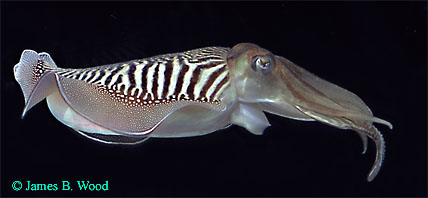
 |
| Home | What's New? | Cephalopod Species | Cephalopod Articles | Lessons | Bookstore | Resources | About TCP | FAQs |
Sepia officinalis, the Common Cuttlefish<< Cephalopod Species | By S. officinalis isn't found in any of the Americas. In fact, no cuttlefish is. S. officinalis lives in the English channel, south in through the Mediterranean Sea along the west coast of Africa to the southern-most point of Africa. Some populations migrate from deep to shallow waters in the summer. S. officinalis isn't found in any of the Americas. In fact, no cuttlefish is. S. officinalis lives in the English channel, south in through the Mediterranean Sea along the west coast of Africa to the southern-most point of Africa. Some populations migrate from deep to shallow waters in the summer.
S. officinalis eat small molluscs (snails, clams, etc), crabs, shrimps and other cuttlefish (!). Some will also eat fish. They are eaten by sharks, fish and other cuttlefish. Life spans of one to two years have been reported for S. officinalis. They can grow to a length of 45 cm (this mantle length, i.e. does not including the head and the arms), but most are smaller, around 20 to 30 cm. They have 8 arms and two tentacles. The tentacles are shot out quickly to capture prey, and the arms are used to hold and move the prey around once it is caught. They have a parot-like beak and a radula to tear and rasp the prey. Like other "shallow water" cephalopods, they have ink that they can use when scared, they move by jet propulsion and can change colour (not any colour, mostly they use very dark browns, light browns and whites. Sometimes they use a bit of orange behind their eyes, or grey in lines along their arms) to hide, or to send signals to other cuttlefish or to predators. They spend a lot of time on the bottom, and usually only swim when they are hungry (to catch prey), or when they meet another cuttlefish (they will fight or mate). After a female has mated, she will lay eggs. Each egg is put into a separate egg case that is about 1-2 cm long. Ink is added to the egg case to make it dark. Each egg case is attached individually to things on the bottom. Cuttlefish can lay eggs several times at the end of their life. Eggs take about 2 months to hatch, but this time depends a lot on the temperature of the water that they are in. Babies are about 50 mm long (again, this is mantle length and does not include the head and arms), and grow quite rapidly. They mostly eat small (less than 50 mm long) crustaceans. Editor's note: For additional information on Sepia officinalis, see James' four part article on cuttlefish husbandry. This is a good well illustrated site on the anatomy of cuttlefish. - James Wood ReferencesBoletzky, S.v. (1983). Sepia officinalis. In Cephalopod Life Cycles, vol. 1. P.R. Boyle (Ed.). Academic, Toronto. pp. 31-52.Roper, C.F.E., M.J. Sweeney and C.E. Nauen (1984). FAO species catalogue. Vol. 3. Cephalopods of the world. An annotated and illustrated catalogue of species of interest to fisheries.FOA Fish. Synop., (125) Vol. 3:277 pp. 47-49.
| ||||||
| Home | What's New? | Cephalopod Species | Cephalopod Articles | Lessons | Resources | About TCP | FAQs | Site Map | |
 |
The Cephalopod Page (TCP), © Copyright 1995-2026, was created and is maintained by Dr. James B. Wood, Associate Director of the Waikiki Aquarium which is part of the University of Hawaii. Please see the FAQs page for cephalopod questions, Marine Invertebrates of Bermuda for information on other invertebrates, and MarineBio.org and the Census of Marine Life for general information on marine biology. |